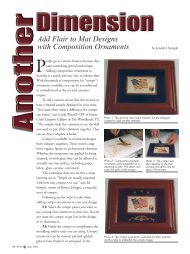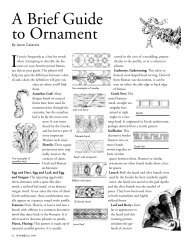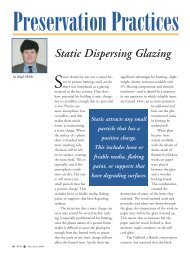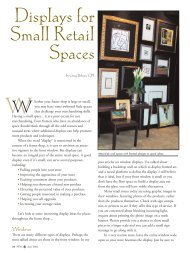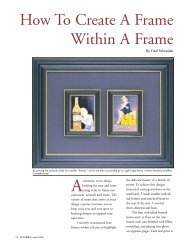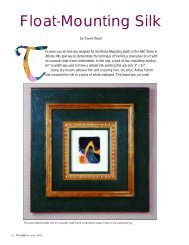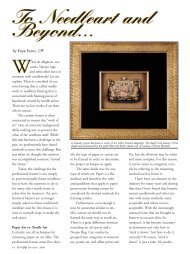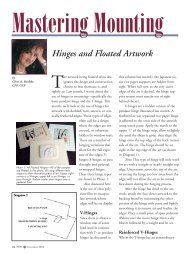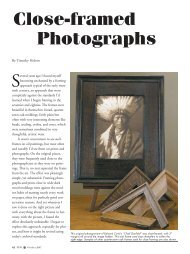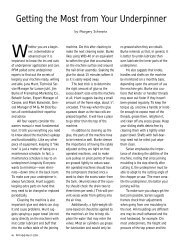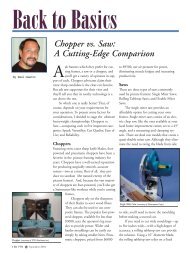TABLE OF CONTENTS - Picture Framing Magazine
TABLE OF CONTENTS - Picture Framing Magazine
TABLE OF CONTENTS - Picture Framing Magazine
You also want an ePaper? Increase the reach of your titles
YUMPU automatically turns print PDFs into web optimized ePapers that Google loves.
Figure 14<br />
the face of the glass and leaving it<br />
extended from that edge while the laminate<br />
is applied to the extended portion<br />
[FIGURE 15]. If the polyethylene side is<br />
applied to the adhesive on the tape, it<br />
will be easier to reposition if it goes<br />
astray and the inert nylon side will face<br />
in toward the art. Other materials such<br />
as rolled polyester sheet can be used to<br />
perform this role but their barrier potential<br />
is not as great.<br />
Figure 15<br />
Any pressure-sensitive tape which<br />
is used to seal a frame will loose its hold<br />
as it ages. The more its adhesive is protected<br />
from oxygen and oxidizing gases,<br />
the longer it will maintain its bond<br />
strength. This is one the purposes in<br />
sheltering the adhesive inside the laminate<br />
in the highly sealed package<br />
described here. The material to which<br />
the tape is applied must also be considered<br />
in assessing the longevity of the<br />
tape bond. Tape stuck to metal will be<br />
sheltered by that metal and tape suck to<br />
glazing and plastic boards will also be<br />
somewhat sheltered by those materials.<br />
Aging gases can still permeate the carrier<br />
of the tape itself or penetrate from its<br />
edges, but this will be significantly less<br />
than the amount which can be expected<br />
to come through a paper board or wood.<br />
Tapes with poor quality ru b b e r<br />
family adhesives can be expected to<br />
oxidize and release their hold sooner<br />
than acrylic family adhesives. Ta p e s<br />
a re not the most physically ru g g e d<br />
method of creating a seal, but the use of<br />
gasketing and pre s s u re sealing re q u i re s<br />
so much support stru c t u re and expense<br />
that it is not yet practical for use in<br />
c o m m e rcial framing.<br />
Having looked at some of the possibilities<br />
for sealing, it should be asked<br />
whether the creation of sealed packages<br />
has any historic precedent. If we look<br />
back to the earliest paintings we find<br />
that they are on the walls of caves which<br />
w e re sealed by geological accident.<br />
When the caves were opened to human<br />
visitation, their paintings began to dete-<br />
riorate and the caves had to be resealed.<br />
Some of our most ancient scrolls and<br />
papyri have remained in jars in caves or<br />
tombs which were well closed for thousands<br />
of years. The beautifully preserved<br />
old master drawings we enjoy<br />
today spent most of their lives bound in<br />
volumes which remained closed and had<br />
a barrier of gold leaf applied to the edges<br />
of their pages.<br />
More understanding and innovation<br />
in the area of proper sealing of frames<br />
will increase the utility of this option for<br />
commercial framers. Until they have the<br />
capacity to fully and carefully control<br />
and monitor the condition of the materials<br />
they use inside the frame, their sealing<br />
of packages must be limited. Today’s<br />
common practice of taping the glazing to<br />
a plastic and paper backing board with<br />
pressure-sensitive tape creates a moderate<br />
degree of seal since water vapor can<br />
enter the package though the paper<br />
layer. The longevity of this seal will be<br />
further limited by the likelihood that the<br />
tape will age and give up its hold<br />
in a few years.<br />
HA N G I N G DE V I C E S<br />
Having made our way to the back<br />
of the frame, hanging devices can<br />
now be considered. If pro p e r l y<br />
designed and installed, this hardw<br />
a re will hold the frame securely on the<br />
wall and can also keep the frame fro m<br />
touching the wall. The importance of<br />
good hard w a re can not be understated.<br />
Countless accidents in which frames fell<br />
o ff the wall and the art they housed was<br />
damaged could have been pre v e n t e d<br />
with improved hanging hard w a re .<br />
Hanging hard w a re is generally<br />
installed on the vertical members of the<br />
frame. This distributes the weight as<br />
evenly as possible. If the hardware is<br />
installed on the top of the frame, it must<br />
be designed so that the top of the frame



